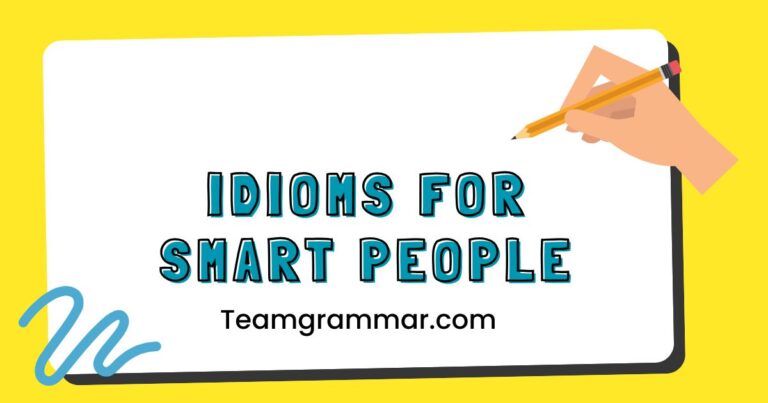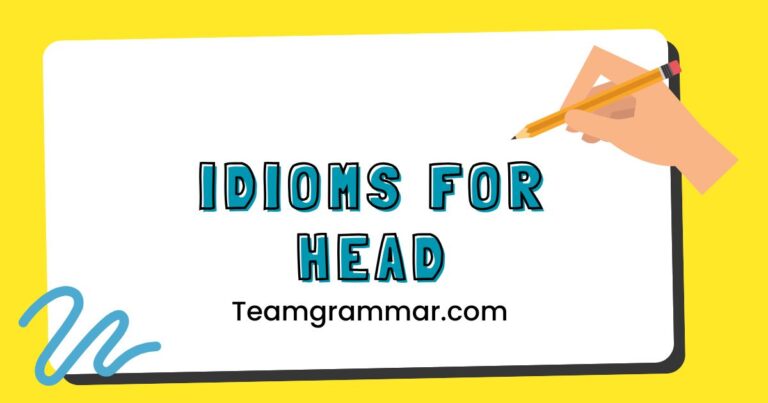39 Idioms for Homework: Mastering Everyday English Expressions
Idioms are a cornerstone of the English language, adding color, depth, and nuance to everyday communication. Understanding idioms is crucial for anyone looking to achieve fluency and a deeper comprehension of English.
This article provides a comprehensive guide to idioms related to “homework,” exploring their meanings, origins, and usage. By mastering these expressions, learners can enhance their vocabulary, improve their communication skills, and gain a more profound appreciation for the richness of the English language.
This guide is designed for students, teachers, and anyone interested in mastering the subtleties of English idioms.
Table of Contents
- Introduction
- What are Idioms?
- Structural Breakdown of Idioms
- Types and Categories of Idioms
- Idioms Related to Homework: Examples
- Usage Rules for Homework Idioms
- Common Mistakes with Homework Idioms
- Practice Exercises
- Advanced Topics in Idiom Usage
- Frequently Asked Questions
- Conclusion
Introduction
Idioms are phrases or expressions whose meanings cannot be understood from the literal definitions of the individual words. They are an integral part of the English language, enriching conversations and adding a layer of cultural understanding.
Learning idioms, especially those related to familiar topics like “homework,” can significantly improve your comprehension and fluency in English. This article serves as a detailed guide to understanding and using idioms associated with homework, helping you to communicate more effectively and naturally.
For English language learners, mastering idioms is often one of the final steps toward achieving true fluency. While grammar and vocabulary provide the building blocks, idioms add the color and personality to the language.
This article will break down complex idioms into manageable parts, providing clear explanations, examples, and exercises to help you master these essential expressions. Whether you are a student, a teacher, or simply someone who wants to improve their English, this guide will offer valuable insights and practical tools for understanding and using idioms related to homework.
What are Idioms?
An idiom is a phrase or expression whose meaning cannot be understood from the literal meanings of its individual words. The overall meaning of an idiom is figurative and culturally specific, often derived from historical events, social customs, or common experiences.
Idioms are a vital part of everyday language, adding color, depth, and nuance to communication. Understanding idioms is essential for achieving fluency and a deeper comprehension of any language, particularly English.
Idioms are classified based on their structural and functional characteristics. Some idioms are metaphorical, using figurative language to convey a specific meaning.
Others are phrasal verbs, which combine a verb with a preposition or adverb to create a new meaning. Still others are proverbs, short sayings that offer general truths or advice.
Regardless of their specific type, idioms share the common characteristic of having a non-literal meaning that must be learned and understood in context.
The function of idioms in language is multifaceted. They add emphasis, convey emotion, and create a sense of shared understanding among speakers.
Idioms can also be used to simplify complex ideas or to express concepts in a more memorable way. In addition, idioms often reflect the cultural values and beliefs of a particular community, providing insights into its history and traditions.
By mastering idioms, learners can gain a more profound appreciation for the richness and complexity of the English language.
Idiom Classification
Idioms can be classified into several categories based on their structure and meaning:
- Phrasal Verbs: These combine a verb with a preposition or adverb (e.g., give up, look into).
- Metaphorical Idioms: These use figurative language to represent something else (e.g., break the ice, a piece of cake).
- Proverbial Idioms: These are short sayings that offer advice or wisdom (e.g., a penny saved is a penny earned, better late than never).
- Clichés: These are overused idioms that have lost their original impact (e.g., raining cats and dogs, as old as time).
Idiom Function
The primary functions of idioms are to:
- Add color and emphasis to language.
- Convey complex ideas in a concise way.
- Reflect cultural values and beliefs.
- Create a sense of shared understanding.
Structural Breakdown of Idioms
Idioms, while seemingly simple, can be complex in their structure. They often defy standard grammatical rules, which is why they can be challenging for language learners.
Understanding the structural components of idioms, such as their fixed nature and non-compositional meaning, is essential for mastering their usage. Idioms are not merely a collection of words; they are fixed expressions with a unique meaning that cannot be derived from the individual words themselves.
One key characteristic of idioms is theirfixed structure. This means that the words in an idiom cannot be easily changed or rearranged without altering its meaning or making it nonsensical.
For example, the idiom “hit the books” cannot be changed to “strike the books” or “books hit” without losing its intended meaning. This fixed structure is one of the main reasons why idioms must be learned as complete units rather than analyzed word by word.
Another important aspect of idioms is theirnon-compositional meaning. This means that the meaning of the idiom cannot be determined by adding up the meanings of its individual words.
Instead, the idiom has a unique, figurative meaning that is different from the literal meaning of its components. For example, the idiom “burn the midnight oil” does not literally involve burning oil at midnight; it means to work or study late into the night.
This non-compositional nature is what makes idioms so challenging but also so interesting to learn.
Fixed Structure
Idioms have a fixed structure, meaning the words and their order cannot be easily changed without losing the idiom’s meaning. This rigidity is a defining characteristic.
Non-Compositional Meaning
The meaning of an idiom cannot be derived from the literal meanings of its individual words. It has a unique, figurative meaning that must be learned.
Types and Categories of Idioms
Idioms can be categorized based on their function, structure, and the context in which they are used. Understanding these categories can help learners to identify and interpret idioms more effectively.
Some common categories include phrasal verbs, metaphorical idioms, and idioms with cultural or historical significance. Recognizing the type of idiom can provide clues to its meaning and usage.
Phrasal verbsare a common type of idiom, consisting of a verb combined with a preposition or adverb. These combinations create new meanings that are often unrelated to the literal meanings of the individual words.
For example, “give up” means to stop trying, while “look into” means to investigate. Phrasal verbs are frequently used in everyday conversation and writing, making them essential for English language learners to master.
Metaphorical idiomsuse figurative language to convey a specific meaning. These idioms often rely on imagery and symbolism to express abstract concepts or emotions.
For example, “break the ice” means to initiate a conversation or make people feel more comfortable, while “a piece of cake” means something is easy to do. Metaphorical idioms add color and expressiveness to language, making it more engaging and memorable.
In addition to phrasal verbs and metaphorical idioms, there are also idioms withcultural or historical significance. These idioms often reflect the values, beliefs, and experiences of a particular community or society.
Understanding the cultural context of these idioms can provide deeper insights into their meaning and usage. For example, “bite the bullet” comes from a historical practice where soldiers would bite on a bullet to cope with pain during surgery.
Knowing this origin can help learners to appreciate the idiom’s meaning and impact.
Phrasal Verbs
Combinations of a verb with a preposition or adverb, creating a new meaning (e.g., look up, break down).
Metaphorical Idioms
Idioms that use figurative language to represent something else (e.g., hit the nail on the head, a drop in the bucket).
Idioms with Cultural or Historical Significance
Idioms that reflect the values, beliefs, and experiences of a particular community or society (e.g., bury the hatchet, spill the beans).
Idioms Related to Homework: Examples
Here are some common idioms related to homework, complete with explanations and example sentences:
The following tables provide a comprehensive list of idioms related to homework, each with its meaning and usage examples. These idioms are categorized to help you understand their context and application better.
Table 1: General Homework Idioms
This table includes idioms that broadly relate to the concept of homework, studying, and academic effort.
| Idiom | Meaning | Example Sentence |
|---|---|---|
| Hit the books | To study hard | I need to hit the books tonight if I want to pass my exam. |
| Burn the midnight oil | To work or study late into the night | She’s been burning the midnight oil to finish her thesis. |
| Crack the books | To open and begin studying | It’s time to crack the books and get ready for the test. |
| Learn by heart | To memorize something perfectly | The students had to learn the poem by heart for the recitation. |
| Know something inside out | To know something very well | He knows the subject inside out, so he’s sure to do well on the exam. |
| Pass with flying colors | To pass easily and with a high score | She passed the test with flying colors after all her hard work. |
| Pull an all-nighter | To stay up all night studying or working | I had to pull an all-nighter to finish the project on time. |
| Read up on something | To get information about a particular subject by reading | I need to read up on quantum physics before the lecture. |
| Study like a dog | To study very hard | He studied like a dog to get into his dream university. |
| Swot up (on something) | To study something very hard, especially for an exam | I need to swot up on Shakespeare before the exam. |
| Bone up on | To study something intensively, usually for a short period | I need to bone up on my history before the quiz tomorrow. |
| Brush up on | To review and improve one’s knowledge of something | I need to brush up on my Spanish before my trip to Spain. |
| Hit the books hard | To study with great intensity | If you want to get a good grade, you need to hit the books hard. |
| Get down to studying | To begin studying seriously | It’s time to get down to studying if we want to be prepared. |
| Be a quick study | To learn something quickly and easily | She’s a quick study and picked up the new material in no time. |
| Cram for an exam | To study intensively for an exam at the last minute | I had to cram for the exam because I procrastinated. |
| Cut class | To skip or miss a class without permission | He decided to cut class and go to the beach instead. |
| Fall behind in class | To not keep up with the required work in a class | If you miss too many classes, you’ll fall behind in class. |
| Ace a test | To get a perfect or very high score on a test | She aced the test because she studied so hard. |
| Skim through | To read something quickly without paying attention to details | I only had time to skim through the chapter before the lecture. |
Table 2: Idioms Related to Difficulty of Homework
This table focuses on idioms that describe the difficulty or ease of completing homework assignments.
| Idiom | Meaning | Example Sentence |
|---|---|---|
| A piece of cake | Very easy | The homework was a piece of cake; I finished it in no time. |
| A walk in the park | Very easy and enjoyable | The exam was a walk in the park compared to what I expected. |
| Not rocket science | Not complicated or difficult to understand | Solving this problem isn’t rocket science; just follow the instructions. |
| A tough row to hoe | A difficult task or situation | Getting through this course is going to be a tough row to hoe. |
| Bite off more than one can chew | To take on more than one can handle | He bit off more than he could chew when he signed up for three advanced courses. |
| Up to one’s ears (in something) | Deeply involved in something, usually a difficult situation | I’m up to my ears in homework this week. |
| In over one’s head | In a situation that one cannot handle | He felt in over his head when he started the advanced math course. |
| Like pulling teeth | Very difficult to do | Getting him to do his homework is like pulling teeth. |
| Run into a brick wall | To encounter an obstacle that prevents progress | I ran into a brick wall trying to solve this equation. |
| Stuck in a rut | Being in a monotonous or unchanging situation | I felt stuck in a rut with the same homework assignments every week. |
| Heavy going | Difficult or tedious | The reading material for this course is really heavy going. |
| Hard nut to crack | A difficult problem or person to deal with | This math problem is a hard nut to crack. |
| A tall order | A difficult task or request | Finishing all this homework by tomorrow is a tall order. |
| Against the clock | Rushing to finish something before a deadline | I’m working against the clock to finish my paper. |
| Make headway | To make progress | I’m finally starting to make headway on this project. |
| Spin one’s wheels | To expend effort without making progress | I feel like I’m just spinning my wheels trying to understand this concept. |
| Go the extra mile | To make an extra effort | She always goes the extra mile to get good grades. |
| Cut corners | To do something poorly in order to save time or money | Don’t cut corners on your homework; it will affect your grade. |
| Easy as pie | Very easy | This homework is easy as pie. |
| A breeze | Very easy | The test was a breeze. |
Table 3: Idioms Related to Collaboration and Seeking Help
This table includes idioms that describe working with others on homework or seeking assistance when needed.
| Idiom | Meaning | Example Sentence |
|---|---|---|
| Two heads are better than one | Working together can solve problems more effectively | Let’s work on this homework together; two heads are better than one. |
| Pick someone’s brain | To ask someone for advice or information | Can I pick your brain about this math problem? |
| Get a leg up | To gain an advantage | Studying with a tutor can get you a leg up on the competition. |
| Compare notes | To share ideas and information | Let’s compare notes after we’ve each studied the chapter. |
| On the same page | In agreement or understanding | We need to make sure we’re on the same page before we start the group project. |
| Get something straight | To clarify or understand something clearly | Let’s get this straight: the homework is due on Friday, not Thursday. |
| Meet minds | To come to an agreement or understanding | After discussing our ideas, we were able to meet minds on the project. |
| Team up | To work together as a team | Let’s team up to tackle this difficult assignment. |
| Brainstorm | To generate ideas in a group | We should brainstorm some ideas before we start writing the essay. |
| Put one’s heads together | To work together to solve a problem | We need to put our heads together to figure out this puzzle. |
| Find one’s feet | To become comfortable and confident in a new situation | It took me a while to find my feet in the new school. |
| Get the hang of something | To learn how to do something | Once you get the hang of it, the homework will be much easier. |
| Learn the ropes | To learn the basics of something | It takes time to learn the ropes when you start a new course. |
| Run something by someone | To get someone’s opinion or approval on something | Can I run my essay by you before I submit it? |
| Sounding board | A person whose advice is sought | My teacher is a great sounding board for my ideas. |
| In sync | Working well together, in agreement | We’re in sync on this project, so it should go smoothly. |
| On the same wavelength | Having the same thoughts or feelings | We’re on the same wavelength, so we understand each other easily. |
| Give someone a hand | To help someone | Can you give me a hand with this problem? |
| Lend an ear | To listen to someone | Can you lend me an ear while I explain this assignment? |
| Pick up the slack | To do the work that someone else has failed to do | I had to pick up the slack when my partner didn’t do his part of the project. |
Usage Rules for Homework Idioms
Using idioms correctly requires an understanding of their specific meanings and contexts. It is important to avoid mixing idioms or using them in inappropriate situations.
Pay attention to the tone and audience when using idioms, as some may be too informal for academic or professional settings. Always ensure that the idiom fits the intended meaning and enhances the communication, rather than confusing it.
One common mistake is to interpret idioms literally, which can lead to misunderstandings. Remember that idioms have figurative meanings that are different from the sum of their individual words.
Another error is to use idioms out of context, which can make the communication sound awkward or unnatural. To avoid these mistakes, it is essential to study idioms in context and practice using them in various situations.
Reading widely and listening to native speakers can also help to develop a better understanding of how idioms are used in real-world communication.
Furthermore, be mindful of the cultural nuances associated with idioms. Some idioms may be specific to certain regions or communities, and using them outside of these contexts can be confusing or even offensive.
When in doubt, it is always best to err on the side of caution and choose more neutral language. By paying attention to these usage rules, learners can master idioms and use them effectively to enhance their communication skills.
Avoiding Literal Interpretations
Always remember that idioms have a figurative meaning, which is different from the literal meanings of the individual words. Avoid interpreting them literally.
Using Idioms in Context
Use idioms appropriately in relevant situations. Pay attention to the tone and audience to ensure that the idiom fits the context and enhances the communication.
Common Mistakes with Homework Idioms
One of the most common mistakes when using idioms is taking them literally. Idioms are figurative expressions, and their meanings cannot be derived from the literal definitions of the individual words.
For example, someone might misunderstand “hit the books” to mean physically striking books, rather than studying diligently.
Another frequent error is using idioms in the wrong context. Idioms are often specific to certain situations or types of communication.
Using an idiom in an inappropriate context can make the speaker sound awkward or unnatural. For example, using a very informal idiom in a formal presentation would be a mistake.
Finally, many learners make the mistake of trying to create their own idioms or altering existing ones. Idioms are fixed expressions, and changing them can render them meaningless or confusing.
It is important to learn idioms as complete units and use them exactly as they are.
Table 4: Common Mistakes and Corrections
This table highlights common mistakes made when using homework-related idioms and provides the correct usage.
| Incorrect | Correct | Explanation |
|---|---|---|
| “I will beat the books tonight.” | “I will hit the books tonight.” | “Hit the books” is the correct idiom for studying hard. |
| “This homework is a slice of cake.” | “This homework is a piece of cake.” | The idiom is “a piece of cake,” not “a slice of cake.” |
| “He is in his head over with homework.” | “He is in over his head with homework.” | The idiom is “in over his head,” meaning he has too much to handle. |
| “Let’s pick your brain on this problem.” | “Let’s pick your brain about this problem.” | The correct preposition is “about,” not “on.” |
| “We have to meet minds on this project.” | “We have to see eye to eye on this project.” | While “meet minds” is understandable, “see eye to eye” is a more common and accurate idiom. |
| “She is burning the midnight fuel.” | “She is burning the midnight oil.” | The correct idiom is “burning the midnight oil,” referring to working late. |
| “I need to learn by heart the poem.” | “I need to learn the poem by heart.” | The correct word order is “learn [something] by heart.” |
| “He passed with green colors.” | “He passed with flying colors.” | The idiom is “passed with flying colors,” not “green colors.” |
| “I have to pull a whole night.” | “I have to pull an all-nighter.” | The correct idiom is “pull an all-nighter.” |
| “Let’s compare our notes together.” | “Let’s compare notes.” | The word “together” is redundant in this context. |
Practice Exercises
Test your understanding of homework idioms with these exercises. Fill in the blanks with the appropriate idiom from the list provided.
Exercise 1: Fill in the Blanks
Choose the correct idiom from the list below to complete each sentence.
Idiom List: hit the books, a piece of cake, pull an all-nighter, in over my head, brush up on
| Question | Answer |
|---|---|
| 1. I have to _______ tonight because I have a big exam tomorrow. | hit the books |
| 2. The test was _______; I finished it in just 30 minutes. | a piece of cake |
| 3. I had to _______ to finish the project on time. | pull an all-nighter |
| 4. I feel _______ in this advanced math class. | in over my head |
| 5. I need to _______ my French before my trip to Paris. | brush up on |
| 6. She decided to _______ because she had a difficult test coming up. | hit the books |
| 7. The assignment was _______ for him, as he had mastered the concepts already. | a piece of cake |
| 8. To meet the deadline, he had to _______ and work through the night. | pull an all-nighter |
| 9. I realized I was _______ when I signed up for too many courses this semester. | in over my head |
| 10. Before traveling, I needed to _______ my knowledge of the local customs. | brush up on |
Exercise 2: Multiple Choice
Choose the best idiom to complete the following sentences.
| Question | Answer |
|---|---|
1. He had to _______ on his physics to pass the exam.
|
b. bone up |
2. The project was so easy; it was _______.
|
b. a walk in the park |
3. They decided to _______ on the assignment to finish it faster.
|
a. team up |
4. If you keep skipping classes, you will _______.
|
a. fall behind |
5. She _______ the test because she studied so hard.
|
b. aced |
6. I had to _______ to understand the new concept.
|
c. do some research |
7. They decided to _______ before tackling the difficult problem.
|
a. put their heads together |
8. He always _______ to ensure he gets good grades.
|
b. goes the extra mile |
9. After a while, she began to _______ in the new course.
|
a. find her feet |
10. Can I _______ before I submit it?
|
b. run my essay by you |
Advanced Topics in Idiom Usage
For advanced learners, understanding the nuances of idiom usage can further enhance their communication skills. This includes recognizing the subtle differences in meaning between similar idioms, understanding the cultural context in which idioms are used, and using idioms creatively to add depth and expressiveness to their language.
Advanced learners can also explore the etymology of idioms to gain a deeper appreciation for their origins and evolution.
Another advanced topic is the use of idioms in different genres of writing and speaking. Formal writing typically requires a more restrained use of idioms, while informal conversations may be filled with colorful expressions.
Understanding these stylistic differences is essential for effective communication in various settings. Additionally, advanced learners can practice using idioms in creative writing, such as poetry and fiction, to add imagery and emotional impact to their work.
Finally, advanced learners can delve into the study of idioms in different dialects of English. Idioms can vary significantly from one region to another, and understanding these variations can provide valuable insights into the cultural diversity of the English-speaking world.
By mastering these advanced topics, learners can achieve a high level of proficiency in idiom usage and communicate with greater confidence and effectiveness.
Nuances in Idiom Meaning
Recognizing the subtle differences in meaning between similar idioms is crucial for precise communication.
Cultural Context of Idioms
Understanding the cultural context in which idioms are used can provide deeper insights into their meaning and usage.
Frequently Asked Questions
- What is the best way to learn idioms?
The best way to learn idioms is through consistent exposure and practice. Read widely, listen to native speakers, and pay attention to how idioms are used in context. Keep a notebook of new idioms and review them regularly. Try to use idioms in your own writing and speaking to reinforce your learning.
- How can I avoid misusing idioms?
To avoid misusing idioms, always ensure that you understand their specific meaning and context. Study idioms in context and practice using them in various situations. If you are unsure about the meaning or usage of an idiom, consult a dictionary or ask a native speaker for clarification.
- Are idioms the same in all English-speaking countries?
No, idioms can vary significantly from one English-speaking country to another. Some idioms may be specific to certain regions or communities. Be mindful of these variations and try to learn the idioms that are commonly used in the specific context you are in.
- Can I create my own idioms?
It is generally not advisable to create your own idioms. Idi
ms are fixed expressions, and changing them can render them meaningless or confusing. It is best to learn and use existing idioms correctly.
- How important is it to know idioms for English fluency?
Knowing idioms is very important for achieving English fluency. Idioms are an integral part of everyday language, and understanding them is essential for comprehending native speakers and communicating effectively. Mastering idioms can significantly enhance your comprehension and fluency in English.
Conclusion
Mastering idioms related to homework can significantly enhance your English language skills. By understanding the meanings, origins, and usage of these expressions, you can communicate more effectively and naturally.
Remember to study idioms in context, practice using them in various situations, and be mindful of their cultural nuances. With consistent effort and attention, you can master idioms and use them to enrich your communication and deepen your appreciation for the English language.
Keep practicing, and soon you’ll find yourself speaking like a native!







